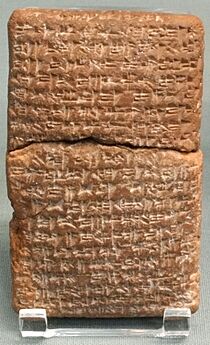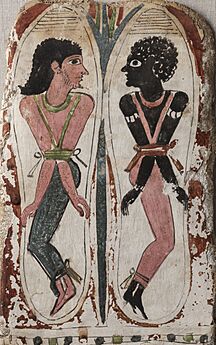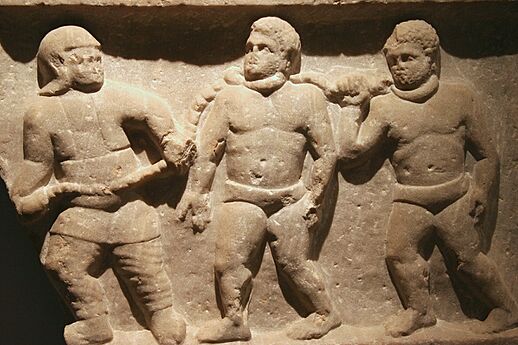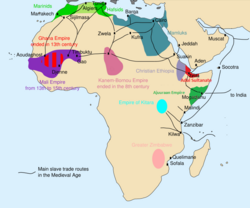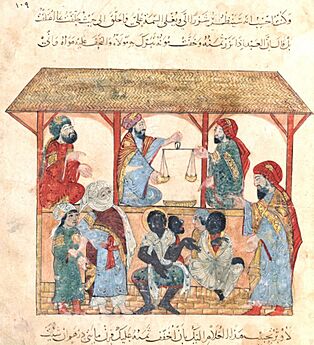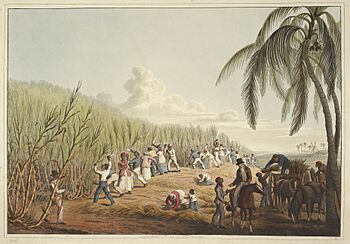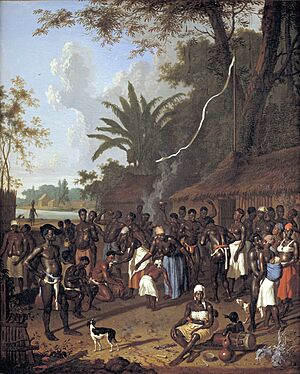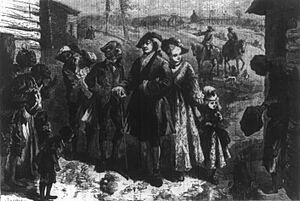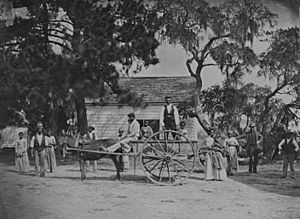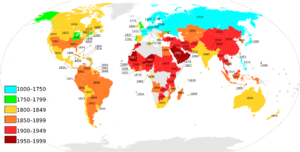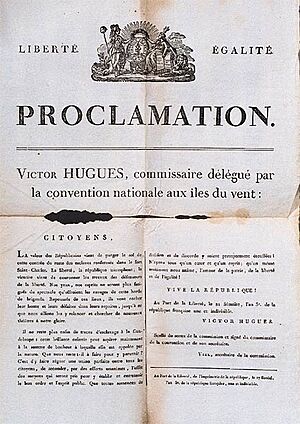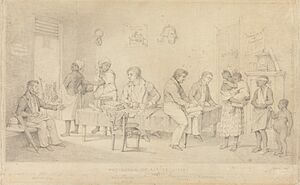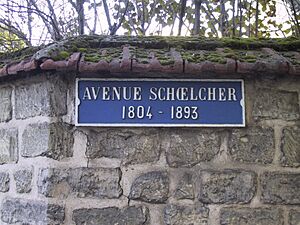History of slavery facts for kids
The history of slavery is a long and complex story. It involves many different cultures, countries, and religions from ancient times until today. People who were enslaved came from many different backgrounds. The lives of enslaved people, their jobs, and their legal rights changed a lot depending on where and when they lived.
Slavery existed even in some groups of hunter-gatherers. But it became much more common when people started farming. This led to more complex societies and economies. Slavery became a regular part of life when the first civilizations appeared. For example, in Sumer (part of Mesopotamia) around 3500 BC, slavery was already present. The ancient Mesopotamian Code of Hammurabi (around 1750 BC) talks about slavery as a normal thing.
Slavery was widespread in ancient Europe, Asia, the Middle East, and Africa. It became less common in Europe during the Early Middle Ages. However, it continued in some areas. Both Christians and Muslims enslaved each other during wars in the Mediterranean and Europe. Islamic slavery mainly happened in Western and Central Asia, North and East Africa, India, and parts of Europe. This was from the 7th to the 20th century. Islamic law allowed the enslavement of non-Muslims. Slaves were brought from non-Muslim lands through various trade routes. These included routes from the North (like the Balkan slave trade and Crimean slave trade), East (the Bukhara slave trade), West (the Andalusian slave trade), and South (the Trans-Saharan slave trade, Red Sea slave trade, and Indian Ocean slave trade).
Starting in the 16th century, European merchants, especially from Portugal, began the transatlantic slave trade. Few traders went far inland in Africa. They wanted to avoid tropical diseases and violence. They mostly bought enslaved Africans from West African kingdoms. These enslaved people were then shipped to European colonies in the Americas. The European traders offered goods like guns, gunpowder, copper manillas, and cloth. The demand for these goods led to more local wars and ways to enslave Africans. This happened in ever-increasing numbers. In India and the Americas, people were forced into slavery to work. The transatlantic slave trade eventually stopped. This happened after European and American governments passed laws abolishing their involvement in it. Efforts to stop slavery included the British Preventative Squadron and the American African Slave Trade Patrol. Slavery was also abolished in the Americas. Later, European countries took political control over much of Africa.
Slavery in Ancient Times
Evidence of slavery exists even before written records. This practice has been part of many cultures for about 11,000 years. It became more common with the invention of farming during the Neolithic Revolution. When societies produced more food than they needed and had many people, mass slavery became possible.
Slavery happened in many ancient civilizations. These include ancient Egypt, ancient China, the Akkadian Empire, Assyria, Babylonia, Persia, ancient Israel, ancient Greece, ancient India, and the Roman Empire. It was also present in Arab Islamic Caliphates and Sultanates, Nubia, pre-colonial empires in Africa, and pre-Columbian civilizations in the Americas. Ancient slavery included different forms. Some people became slaves because of debts. Others were punished for crimes or captured in war. Sometimes, abandoned children became slaves. Children born to enslaved parents were also enslaved.
-
Enslaved people in chains during Roman rule at Smyrna (now İzmir). Around 200 AD.
Slavery in Ancient Greece
Slavery in Ancient Greece is recorded as far back as Mycenaean Greece. We don't know exactly how it started. But it became a big part of the economy and society after cities were built. Slavery was very common in ancient Greece, just like in other societies at that time. It's thought that in Athens, most citizens owned at least one enslaved person.
Most ancient writers thought slavery was natural and necessary. But some people, especially in Socratic dialogues, started to question it. The Stoics were the first to speak out against slavery in recorded history.
During the 8th and 7th centuries BC, in the Messenian Wars, the Spartans enslaved a whole population. These people were called helots. According to Herodotus, helots were seven times more numerous than Spartans. After several helot revolts around 600 BC, the Spartans changed their city-state. They made it very strict and military-focused. Their leaders believed this was the only way to control the large helot population. In some Ancient Greek city-states, about 30% of the people were enslaved. Both paid workers and enslaved workers were important.
Slavery in Ancient Rome
The Romans learned about slavery from the Greeks and Phoenicians. As the Roman Republic grew, it enslaved entire populations. This provided many workers for Roman farms, quarries, and homes. Enslaved people in Roman slavery came from all over Europe and the Mediterranean. They were used for labor and also for entertainment, like gladiators.
In the late Republic, many newly enslaved people worked on large farms and ranches. This led to big slave revolts. The Third Servile War, led by Spartacus, was the most famous and dangerous for Rome.
Slavery in Africa
Historian Fernand Braudel wrote in 1984 that slavery was common in Africa from the 15th to the 18th century. It was a normal part of daily life. Slavery took many forms. There were enslaved people who worked for the court or in armies. Others were domestic servants, farm workers, or worked in industries. Some even worked as messengers or traders.
In the 16th century, Europe started to transport more enslaved people from Africa to the Americas than the Arab world. The Dutch brought enslaved people from Asia to their colony at the Cape of Good Hope (now Cape Town) in the 17th century. In 1807, Britain made the slave trade illegal within its empire. Britain then worked to stop the slave trade in other areas. The United States did the same in 1808.
In Senegambia, from 1300 to 1900, about one-third of the people were enslaved. In early Islamic states in the Western Sudan, like Ghana (750–1076) and Mali (1235–1645), about a third of the population was enslaved. The earliest Akan state of Bonoman had one-third of its people enslaved in the 17th century. In Sierra Leone in the 19th century, about half the population was enslaved.
In the 19th century, at least half the population was enslaved among the Duala of Cameroon, the Igbo and other groups of the lower Niger, the Kongo, and the Kasanje kingdom and Chokwe of Angola. Among the Ashanti and Yoruba, one-third of the population was enslaved. The population of the Kanem was about one-third enslaved. It was perhaps 40% in Bornu (1396–1893). From 1750 to 1900, one to two-thirds of the people in the Fulani jihad states were enslaved. The Sokoto caliphate in northern Nigeria and Cameroon had half its population enslaved in the 19th century. It is estimated that up to 90% of the people in Arab-Swahili Zanzibar were enslaved. Roughly half the population of Madagascar was enslaved.
Slavery in Ethiopia continued until 1942. The Anti-Slavery Society estimated that in the early 1930s, there were 2,000,000 enslaved people in Ethiopia. This was out of a population of 8 to 16 million. Emperor Haile Selassie finally abolished slavery on August 26, 1942.
When British rule began in the Sokoto Caliphate and nearby areas in northern Nigeria around 1900, about 2 to 2.5 million people were enslaved. Slavery in northern Nigeria was finally outlawed in 1936.
-
A 13th-century slave market in Yemen.
Slavery in the Americas

To take part in the slave trade in Spanish America, bankers and trading companies had to pay the Spanish king for a special license. This license was called the Asiento de Negros. However, much of the trade happened illegally. After 1670, when the Spanish Empire became weaker, it let other countries handle parts of the slave trade. These included the Dutch (1685–1687), Portuguese, French (1698–1713), and English (1713–1750). They also set up organized storage places for enslaved people in the Caribbean islands.
After the War of the Spanish Succession, the British government gained the right to be the only ones to sell African slaves in Spanish America. This was given to the South Sea Company. Meanwhile, slave trading became a main business for private companies in the Americas.
Slavery Among Indigenous Peoples
In Pre-Columbian Mesoamerica, the most common forms of slavery involved prisoners of war and people who owed money. People who couldn't pay their debts might have to work as slaves until their debts were paid off. This was a form of indentured servitude. Warfare was important to Maya society. Raids on nearby areas provided people for human sacrifice and slaves to build temples. Most people sacrificed were prisoners of war or enslaved.
Slavery was usually not passed down from parents to children. Children of enslaved people were born free. In the Inca Empire, workers paid taxes by working for the government. This system was called mita. Each ayllu, or extended family, would choose a family member to do the work. It's not clear if this forced labor counts as slavery. The Spanish later used this system, especially for their silver mines in Bolivia.
Other groups in the New World also had enslaved people. These included the Tehuelche of Patagonia, the Comanche of Texas, the Caribs of Dominica, and the Tupinambá of Brazil. Fishing societies along the West Coast of North America, like the Yurok, also had enslaved people. Many indigenous peoples of the Pacific Northwest Coast, such as the Haida and Tlingit, were known as strong warriors and slave traders. They raided as far as California. Slavery was passed down in families, with enslaved people often being prisoners of war or their descendants. Among some Pacific Northwest tribes, about a quarter of the population was enslaved. An Englishman named John R. Jewitt wrote about his life as an enslaved person after his ship was captured in 1802. His story shows that many people were held as slaves.
Slavery in the British and French Caribbean
Slavery was widely used in the parts of the Caribbean controlled by France and the British Empire. The Lesser Antilles islands like Barbados, St. Kitts, Antigua, Martinique, and Guadeloupe were the first important slave societies in the Caribbean. They started using enslaved Africans widely by the late 17th century. This happened as their economies shifted to sugar production.
England had many sugar colonies in the Caribbean. These included Jamaica, Barbados, Nevis, and Antigua. They provided a steady supply of sugar. Enslaved labor produced this sugar. By the 1700s, there were more enslaved people in Barbados than in all the English colonies on the mainland combined. Barbados did not have many mountains, so English planters could clear land for sugarcane.
At first, indentured servants were sent to Barbados to work in the sugar fields. They were treated so badly that fewer indentured servants came. There weren't enough people to work the fields. This is when the British started bringing in enslaved Africans. For the English planters in Barbados, using enslaved labor was necessary. It allowed them to make money from sugar production for the growing market in Europe.
In the Treaty of Utrecht, which ended the War of the Spanish Succession (1702–1714), European powers also discussed colonial issues. A key part of the talks was Britain getting a 30-year monopoly to sell enslaved people in Spanish America. This was called the Asiento de Negros. Queen Anne also allowed her North American colonies like Virginia to make laws that encouraged importing enslaved people. Queen Anne had secretly negotiated with France to get its approval for the Asiento. In 1712, she announced her success in taking the Asiento from France. Many London merchants celebrated this economic win. Most of the slave trade involved sales to Spanish colonies in the Caribbean and Mexico. It also included sales to European colonies in the Caribbean and North America.
By 1778, the French were importing about 13,000 Africans for enslavement each year to the French West Indies.
To control slavery, Louis XIV created the Code Noir in 1685. This was a slave code that gave some human rights to enslaved people. It also set responsibilities for the masters. Masters had to feed, clothe, and care for their enslaved people. Free people of color owned one-third of the plantation property and one-quarter of the enslaved people in Saint Domingue (later Haiti).
Slavery in the First Republic was abolished on February 4, 1794. When it became clear that Napoleon planned to bring back slavery in Saint-Domingue (Haiti), Jean-Jacques Dessalines and Alexandre Pétion changed sides in October 1802. On January 1, 1804, Dessalines, the new leader, declared Haiti a free republic. Haiti became the second independent nation in the Western Hemisphere, after the United States. This was the only successful slave rebellion in world history.
In 1833, the British government announced that enslaved people in British colonies would be completely freed by 1838. In the meantime, the government told enslaved people they had to stay on their plantations. They would have the status of "apprentices" for the next six years.
In Port-of-Spain, Trinidad, on August 1, 1834, a group of mainly older Black people were addressed by the Governor. They started chanting: "Pas de six ans. Point de six ans" ("Not six years. No six years"). Their voices drowned out the Governor. Peaceful protests continued until a decision to abolish apprenticeship was passed. Full emancipation was legally granted earlier than planned, on August 1, 1838. This made Trinidad the first British colony with enslaved people to completely abolish slavery.
After Great Britain abolished slavery, it started to pressure other nations to do the same. France also abolished slavery. By then, Saint-Domingue had already won its independence and formed the independent Republic of Haiti. However, France still controlled Guadeloupe, Martinique, and some smaller islands.
Slavery in Canada
Slavery in Canada was practiced by First Nations and continued during the European colonization of Canada. It's estimated that there were about 4,200 enslaved people in the French colony of Canada and later British North America between 1671 and 1831. Two-thirds of these were of indigenous background (often called panis). The other third were of African descent. They worked as house servants and farm workers. The number of enslaved Black people increased during British rule, especially after 1783 with the arrival of United Empire Loyalists. A small part of Black Canadians today are descendants of these enslaved people.
Slavery in the Canadas ended through court decisions. It faded out in the early 19th century as enslaved people sued for their freedom. Courts in both Lower Canada and Nova Scotia made slavery hard to enforce. In Lower Canada, after court decisions in the late 1790s, an enslaved person "could not be forced to serve longer than they wanted, and ... might leave their master at will." Upper Canada passed the Act Against Slavery in 1793. This was one of the earliest anti-slavery laws in the world. Slavery was formally banned throughout most of the British Empire, including the Canadas, in 1834. This happened after the Slavery Abolition Act 1833 was passed in the British parliament.
These actions led to many Black people (both free and enslaved) moving to Canada from the United States. This happened after the American Revolution (they were known as Black Loyalists). It happened again after the War of 1812, with many Black Refugees settling in Canada. In the mid-19th century, British North America was a destination for the Underground Railroad. This was a network of routes used by enslaved African-Americans to escape from slave states.
Slavery in Latin America

From the late 19th century to the early 20th century, the demand for rubber led to more slavery in Latin America. Harvesting rubber required a lot of labor. Indigenous peoples were enslaved as part of the rubber boom in Ecuador, Peru, Colombia, and Brazil. In Central America, rubber tappers enslaved the indigenous Guatuso-Maleku people for domestic service.
Slavery in the United States
Early History of Slavery in the US
In late August 1619, a ship called the White Lion arrived at Point Comfort, Virginia. It was a privateer ship, but it flew a Dutch flag. This ship brought the first recorded enslaved people from Africa to Virginia. These approximately 20 Africans were from present-day Angola. The White Lion's crew had taken them from a Portuguese cargo ship, the São João Bautista.
Historians are not sure if slavery officially began in the colony at this time. This is because some of these people might have had the status of indentured servants. Most historians agree that both Black enslaved people and indentured servants existed by 1640.
Only a small part of the enslaved Africans brought to the New World came to British North America. Perhaps as little as 5% of the total. Most enslaved people were sent to the Caribbean sugar colonies, Brazil, or Spanish America.
By the 1680s, with the growth of England's Royal African Company, more enslaved Africans arrived in English colonies. The British government continued to support slavery. Colonists then started buying enslaved people in larger numbers.
Slavery in American Colonial Law
- 1640: Virginia courts sentenced John Punch to lifelong slavery. This was the first legal approval of slavery in English colonies.
- 1641: Massachusetts made slavery legal.
- 1650: Connecticut made slavery legal.
- 1652: Rhode Island banned the enslavement of any white or Black person for more than ten years or beyond the age of 24.
- 1654: Virginia allowed "the right of Black people to own slaves of their own race." This happened after African Anthony Johnson, a former indentured servant, sued to have another African, John Casor, declared a "slave for life" instead of an indentured servant.
- 1661: Virginia officially recognized slavery by law.
- 1662: A Virginia law stated that children born would have the same status as their mother.
- 1663: Maryland made slavery legal.
- 1664: Slavery was made legal in New York and New Jersey.
- 1670: Carolina (later South Carolina and North Carolina) was founded. It was mainly settled by planters from the crowded British sugar island colony of Barbados. They brought many enslaved Africans from that island.
- 1676: Rhode Island banned the enslavement of Native Americans.
Growth of Slavery
The change from using indentured servants to enslaved Africans happened for a reason. There were fewer former servants who had finished their contracts. These freed servants then became competitors to their former masters. These newly freed servants often struggled to support themselves. The tobacco industry was increasingly controlled by large planters. This caused unrest, leading to Bacon's Rebellion. Eventually, chattel slavery (where enslaved people were treated as property) became common in areas with large plantations.
The Fundamental Constitutions of Carolina created a system where enslaved people were completely under their master's control. With the rise of a plantation economy in the Carolina Lowcountry based on rice farming, a society of enslaved people was created. This later became the model for the "King Cotton" economy across the Deep South. This South Carolina model was driven by a large enslaved population. It required harsh and often brutal force to control them. To justify such a society, the idea of white supremacy developed in the American colonies.
Several local slave rebellions happened in the 17th and 18th centuries. These included the Gloucester County, Virginia Revolt (1663), the New York Slave Revolt of 1712, the Stono Rebellion (1739), and the New York Slave Insurrection of 1741.
Early United States Law
Within the British Empire, the Massachusetts courts started to follow England. In 1772, England became the first country to outlaw the slave trade within its borders (see Somerset v Stewart). Scotland followed with the Knight v. Wedderburn decision in 1778. Between 1764 and 1774, seventeen enslaved people in Massachusetts courts sued their owners for freedom. In 1766, John Adams' colleague Benjamin Kent won the first trial in what is now the United States to free an enslaved person (Slew vs. Whipple).
The Republic of Vermont allowed the enslavement of children in its 1777 constitution. It suggested that people "ought not" enslave adults, but this was not enforced. Vermont joined the United States in 1791 with the same rules. Through the Northwest Ordinance of 1787, slavery was banned in the territories northwest of the Ohio River. In 1794, Congress banned American ships from being used in the slave trade. It also banned exporting enslaved people from America to other countries. However, little was done to enforce this law. Slave ship owners in Rhode Island continued trading. In 1806, the USA's slave fleet was estimated to be nearly 75% as large as Britain's. It dominated the transport of enslaved people to Cuba.
By 1804, abolitionists succeeded in passing laws that ended legal slavery in every northern state. (Enslaved people above a certain age were legally changed to indentured servants). Congress passed an Act Prohibiting Importation of Slaves starting January 1, 1808. But this did not stop the internal slave trade within the US.
Despite the actions of abolitionists, free Black people faced racial segregation in the Northern states. While the United Kingdom did not ban slavery throughout most of its empire, including British North America, until 1833, free Black people found safety in the Canadas. This happened after the American Revolutionary War and again after the War of 1812. Enslaved people escaped the South across the Ohio River to the North using the Underground Railroad. Midwestern state governments used States Rights arguments to refuse federal power over fugitives. Some juries used their right of jury nullification. They refused to convict those accused under the Fugitive Slave Act of 1850.
After the Kansas–Nebraska Act was passed in 1854, fighting broke out in Kansas Territory. The question of whether it would join the Union as a slave state or a free state was left to its residents. The radical abolitionist John Brown was involved in the violence in "Bleeding Kansas." A major turning point in public opinion was the fraud of the Lecompton Constitution. Pro-slavery groups from Missouri arrived first in Kansas. They quickly set up a territorial government that excluded abolitionists. Through government actions and violence, the pro-slavery group tried to force the unpopular pro-slavery Lecompton Constitution through the state. This angered Northern Democrats, who supported popular sovereignty. It got worse when the Buchanan administration broke a promise to let the constitution be voted on. Anti-slavery lawmakers took office under the new Republican Party.
The Supreme Court in the Dred Scott decision of 1857 said that a person could take their property anywhere. This included taking enslaved people (who were considered property) into a free territory. It also said that African Americans could not be federal citizens. Outraged critics in the North said these events showed the Slave Power (politically organized slave owners) taking more control of the nation.
American Civil War
The enslaved population in the United States was four million. Ninety-five percent of Black people lived in the South. They made up one-third of the population there, compared to 1% in the North. The main political issue in the 1850s was whether slavery would expand into the western territories. Settlers from the Northern states opposed this. The Whig Party split and fell apart over slavery. In the North, it was replaced by the new Republican Party. This party was dedicated to stopping the spread of slavery.
Republicans gained control in every northern state. They did this by joining with a group of anti-slavery Democrats. They warned that slavery was a backward system that hurt liberal democracy and economic growth. Many compromise ideas were suggested, but they all failed. Most Northern voters wanted to stop the expansion of slavery. They believed this would eventually end slavery. Southern voters were very angry. They felt they were being treated as second-class citizens.
In the election of 1860, the Republicans elected Abraham Lincoln as President of the United States. His party also gained control of the United States Congress. The states of the Deep South believed that the economic power of "King Cotton" would defeat the North. They also thought Europe would support them. So, they voted to leave the U.S. (the Union). They formed the Confederate States of America, promising to keep slavery. War broke out in April 1861. Both sides saw many young men volunteer to form new armies. In the North, the main goal was to keep the Union together.
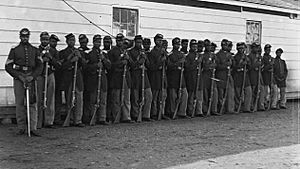
Rebel leaders like Jefferson Davis, Robert E. Lee, and Nathan Bedford Forrest were slave owners and traders.
By 1862, most Northern leaders realized that slavery, the main reason for Southern secession, had to be attacked directly. All the border states rejected President Lincoln's idea for compensated emancipation (paying owners to free enslaved people). However, by 1865, all had started to abolish slavery, except Kentucky and Delaware.
The Emancipation Proclamation was an executive order issued by Lincoln on January 1, 1863. It instantly changed the legal status of 3 million enslaved people in specific areas of the Confederacy from "slave" to "free." This meant that as soon as an enslaved person escaped Confederate control, they became legally free. Plantation owners, knowing that emancipation would ruin their economic system, sometimes moved their enslaved people far away from the Union Army. By June 1865, the Union Army controlled all of the Confederacy and freed all the designated enslaved people. The owners were never paid for their loss. About 186,000 free Black people and newly freed people fought for the Union in the Army and Navy. This helped them claim full citizenship.
The war and Reconstruction caused great hardship for the Black population. Many suffered from sickness and death. After being freed, many Freedmen stayed on the same plantation. Others fled or went to refugee camps run by the Freedmen's Bureau. The Bureau provided food, housing, clothing, medical care, church services, some schooling, legal help, and arranged labor contracts.
Fierce debates about the rights of the Freedmen and the defeated Confederates marked the Reconstruction Era, from 1863 to 1877. These debates often involved killings of Black leaders. Slavery was never brought back. But after President Ulysses S. Grant left the White House in 1877, white-supremacist "Redeemer" Southern Democrats took control of all the southern states. Black people lost almost all the political power they had gained during Reconstruction. By 1900, they also lost the right to vote. They became second-class citizens. Most lived in the rural South in poverty. They worked as laborers, sharecroppers, or tenant farmers. A small number owned their own land. The black churches, especially the Baptist Church, were the center of community activity and leadership.
Abolitionist Movements
Slavery has existed in various forms throughout human history. So have movements to free large groups of enslaved people. However, abolitionism is different from efforts to help a specific group or to limit one practice, like the slave trade.
Drescher (2009) explains the history of slavery's abolition, focusing on its start in Western Europe. Around 1500, slavery had almost disappeared in Western Europe. But it was common almost everywhere else. Imperial powers like the British, French, Spanish, Portuguese, and Dutch built global empires. These empires relied mostly on plantation farming using enslaved people brought from Africa. However, these powers tried to keep slavery to a minimum in their home countries. In 1807, Britain and soon after, the United States, made the international slave trade illegal. The Royal Navy became very good at stopping slave ships. They freed the captives and brought the crew to trial.
There were many slave revolts in the Caribbean. But the only successful uprising happened in the French colony of Haiti in the 1790s. There, enslaved people rose up, fought against the French, and established the independent Republic of Haiti.
The continued profits from slave-based plantations and fears of race war slowed the growth of abolition movements. This was true during the first half of the 19th century. These movements were strongest in Britain, and after 1840, in the United States. The Northern states of the United States abolished slavery between 1777 and 1804. This was partly in response to the United States Declaration of Independence. Britain ended slavery in its empire in the 1830s. However, the plantation economies of the southern United States (based on cotton) and those in Brazil and Cuba (based on sugar) grew and became even more profitable.
The bloody American Civil War ended slavery in the United States in 1865. The system ended in Cuba and Brazil in the 1880s. This was because it was no longer profitable for the owners. Slavery continued to exist in Africa. There, Arab slave traders raided Black areas for new captives to be sold. European colonial rule and diplomatic pressure slowly ended the trade, and eventually, the practice of slavery itself.
Abolition in Britain
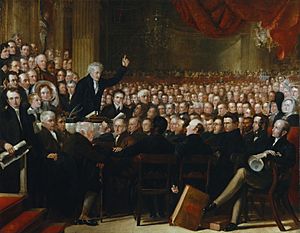
In 1772, the Somersett Case in the English Court of King's Bench ruled that it was illegal to forcibly take an enslaved person abroad. This case has sometimes been wrongly understood to mean that slavery was illegal in England. (It was not illegal elsewhere in the British Empire at that time). A similar case, that of Joseph Knight, happened in Scotland five years later. It ruled that slavery was against Scottish law.
Campaigners in the United Kingdom, like William Wilberforce, Henry Dundas, 1st Viscount Melville, and Thomas Clarkson, worked hard. They founded the Society for Effecting the Abolition of the Slave Trade in May 1787. The Act for the Abolition of the Slave Trade was passed by Parliament on March 25, 1807. It took effect the next year. The act fined £100 for every enslaved person found on a British ship. The goal was to completely outlaw the Atlantic slave trade within the entire British Empire.
The abolition of the British slave trade was very important because of the huge number of people Britain had transported. Britain shipped 2,532,300 Africans across the Atlantic. This was 41% of the total 6,132,900 individuals transported. This made the British Empire the biggest contributor to the slave trade. So, the abolition act was very damaging to the global trade of enslaved people. Britain used its diplomatic power to pressure other nations to sign treaties banning their slave trade. They also gave the Royal Navy the right to stop slave ships sailing under other flags.
The Slavery Abolition Act, passed on August 1, 1833, outlawed slavery itself throughout the British Empire, except for India. On August 1, 1834, enslaved people became "apprentices" to their former owners for six years. Full emancipation was granted earlier than planned, on August 1, 1838. Britain abolished slavery in both Hindu and Muslim India with the Indian Slavery Act, 1843.
The Society for the Mitigation and Gradual Abolition of Slavery Throughout the British Dominions (later London Anti-slavery Society) was founded in 1823 and existed until 1838. Domestic slavery practiced by educated African elites (and traditional rulers) in Sierra Leone was abolished in 1928. A study found that domestic slavery was still common in rural areas in the 1970s.
The British and Foreign Anti-Slavery Society, founded in 1839, still exists today as Anti-Slavery International.
Abolition in France
There were enslaved people in Metropolitan France (especially in trade ports like Nantes or Bordeaux). But slavery was never officially allowed there. A legal case involving Jean Boucaux in 1739 clarified the unclear legal status of possible enslaved people in France. This led to laws that created registers for enslaved people in mainland France. Their stay was limited to three years for visits or learning a trade. Unregistered "slaves" in France were considered free. However, slavery was very important to the economy of France's Caribbean possessions, especially Saint-Domingue.
First Abolition in France
In 1793, the French Declaration of the Rights of Man and of the Citizen (August 1789) influenced events. Also, a huge slave revolt in August 1791, which became the Haitian Revolution, threatened to ally with the British. Because of this, the Revolutionary French commissioners Léger-Félicité Sonthonax and Étienne Polverel declared general emancipation. This was to bring the enslaved people back to France's side. In Paris, on February 4, 1794, Abbé Grégoire and the Convention officially abolished slavery in all French territories outside mainland France. They freed all enslaved people for both moral and security reasons.
Napoleon Restores Slavery
Napoleon came to power in 1799. He soon had big plans for the French sugar colonies. To achieve them, he brought back slavery. Napoleon's main adventure in the Caribbean was sending 30,000 troops in 1802. Their goal was to retake Saint Domingue (Haiti) from former enslaved people who had revolted under Toussaint L'Ouverture. Napoleon wanted to keep France's financial benefits from the colony's sugar and coffee crops. He then planned to set up a major base at New Orleans. So, he re-established slavery in Haiti and Guadeloupe, where it had been abolished after rebellions.
Enslaved people and free Black people fought the French for their freedom and independence. Revolutionary ideas were central to the fighting. The enslaved people and their allies fought for the revolutionary ideals of freedom and equality. Meanwhile, the French troops under General Charles Leclerc fought to bring back the old system. The goal of bringing back slavery went against the ideals of the French Revolution. The French soldiers could not handle tropical diseases, and most died of yellow fever. Slavery was brought back in Guadeloupe but not in Haiti. Haiti became an independent Black republic. Napoleon's huge colonial dreams for Egypt, India, the Caribbean, Louisiana, and even Australia all failed. This was because he lacked a navy strong enough to match Britain's Royal Navy. Realizing the failure, Napoleon ended the Haiti project. He brought home the survivors and sold the huge Louisiana territory to the US in 1803.
Napoleon decreed the abolition of the slave trade when he returned from Elba. This was an attempt to please Britain. His decision was confirmed by the Treaty of Paris on November 20, 1815. It was also confirmed by order of Louis XVIII on January 8, 1817. However, illegal trading continued despite punishments.
Victor Schœlcher and the 1848 Abolition
Slavery in the French colonies was finally abolished in 1848. This was three months after the start of the revolution against the July Monarchy. It was largely due to the tireless 18-year campaign of Victor Schœlcher. On March 3, 1848, he was appointed under-secretary of the navy. He then caused a decree to be issued by the temporary government. This decree recognized the principle of freeing enslaved people throughout the French possessions. He also wrote the decree of April 27, 1848. In it, the French government announced that slavery was abolished in all its colonies.
Abolition in the United States
In 1688, four German Quakers in Germantown wrote a protest against slavery. They presented it to their local Quaker Meeting. It was ignored for 150 years. But in 1844, it was rediscovered and became popular with the abolitionist movement. The 1688 Petition was the first American public document of its kind to protest slavery. It was also one of the first public documents to define universal human rights.
The American Colonization Society was the main group for returning Black Americans to greater freedom in Africa. It established the colony of Liberia in 1821–23. The idea was that former American enslaved people would have more freedom and equality there. Various state colonization societies also had African colonies. These later merged with Liberia. They included the Republic of Maryland, Mississippi-in-Africa, and Kentucky in Africa. These societies helped thousands of African Americans move to Liberia. ACS founder Henry Clay stated that because of "unconquerable prejudice resulting from their color, they never could mix with the free whites of this country." He believed it was good for both groups to "drain them off." Abraham Lincoln, who strongly supported Clay, agreed with his view on returning Black people to their own land.
Enslaved people in the United States who escaped often made their way to the Northern United States and Canada. They used the "Underground Railroad". Famous African American abolitionists included former enslaved people like Harriet Tubman, Sojourner Truth, and Frederick Douglass. Many more people who opposed slavery and worked for its abolition were white Northerners, such as William Lloyd Garrison and John Brown. Slavery was legally abolished in 1865 by the Thirteenth Amendment to the United States Constitution.
While abolitionists agreed that slavery was evil, they had different ideas about what should happen after African Americans were freed. By the time of Emancipation, African Americans were native to the United States and did not want to leave. Most believed that their labor had made the land theirs, just as much as it was for white people.
Congress of Vienna
The Declaration of the Powers, on the Abolition of the Slave Trade, of 8 February 1815 was part of the Final Act of the Congress of Vienna that same year. Its first sentence mentioned "principles of humanity and universal morality." These were given as reasons for ending a trade that was "odious in its continuance."
Images for kids
-
A plate in the Boxer Codex possibly showing alipin (slaves) in the pre-colonial Philippines.
-
Bombardment of Algiers by Lord Exmouth in August 1816, by Thomas Luny.
-
Illustration from the book: The Black Man's Lament, or, how to make sugar by Amelia Opie. (London, 1826).
See also
 In Spanish: Historia de la esclavitud para niños
In Spanish: Historia de la esclavitud para niños
- Debt bondage
- Gulag
- Indentured servitude
- Blackbirding
- Abolitionism
- Compensated emancipation
- Abolitionism in the United States
- Anti-Slavery International, founded as the British and Foreign Anti-Slavery Society in 1839
- Anti-Slavery Society (1823–1838)
- Quakers – Religious Society of Friends
- Society for Effecting the Abolition of the Slave Trade (1787–1807?)
- United States National Slavery Museum


